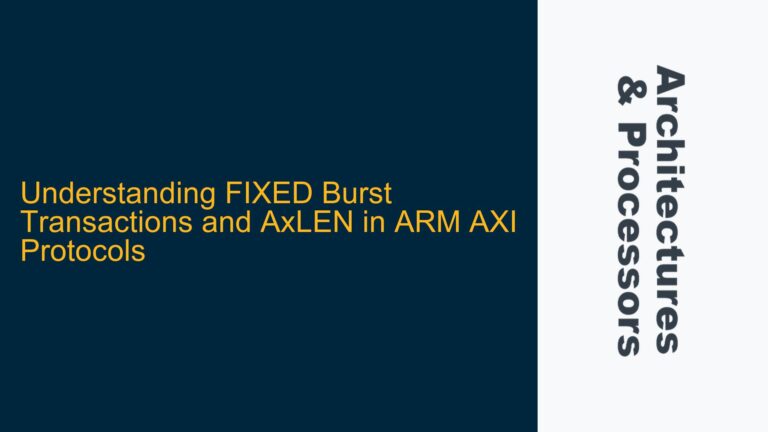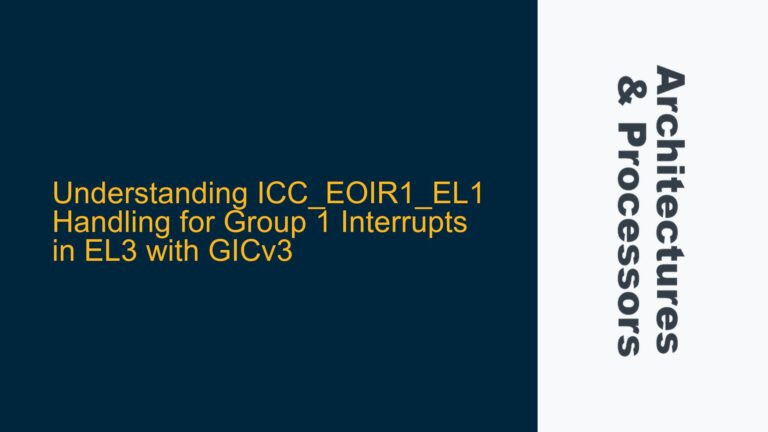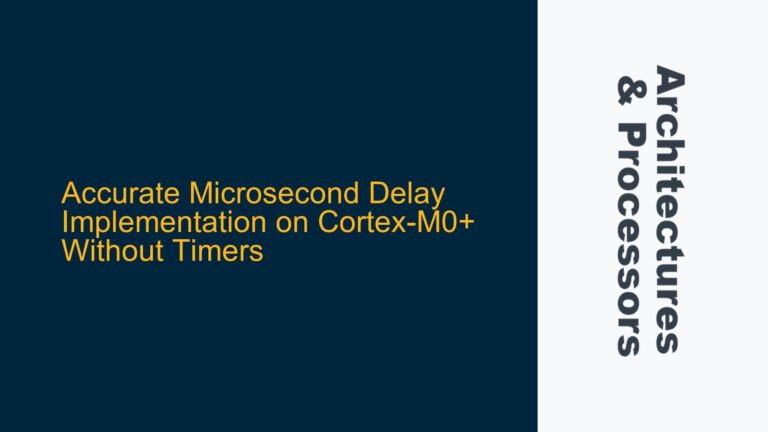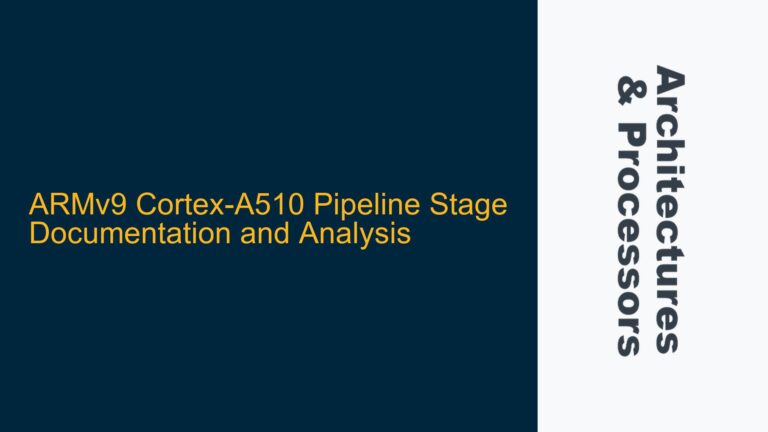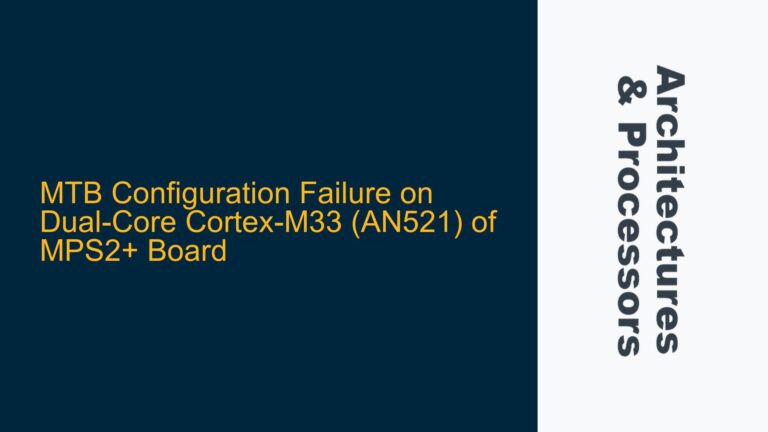ARMv9 NEON Instruction Cycle Timing Documentation Gaps
The ARMv9 architecture represents a significant evolution in ARM’s processor designs, introducing advanced features such as Scalable Vector Extension 2 (SVE2) and enhanced security capabilities. However, one area where developers face challenges is obtaining detailed cycle timing information for NEON instructions in ARMv9 processors. NEON, ARM’s advanced SIMD (Single Instruction, Multiple Data) technology, is widely used for accelerating multimedia, signal processing, and machine learning workloads. Understanding the cycle timing of NEON instructions is critical for optimizing performance-sensitive applications, particularly in real-time systems where deterministic behavior is required.
The absence of publicly available cycle timing documentation for ARMv9 NEON instructions contrasts with earlier architectures like ARMv7 and ARMv8, where such details were often provided in technical reference manuals. For instance, the Cortex-A9 NEON Media Processing Engine Technical Reference Manual includes a section on VFP (Vector Floating Point) instruction timing, which has been a valuable resource for developers. However, ARMv9 documentation, particularly for NEON, appears to lack equivalent details, leaving developers to rely on empirical testing or incomplete information.
This documentation gap can lead to inefficiencies in code optimization, as developers may struggle to predict the performance impact of specific NEON instructions. Additionally, the lack of cycle timing information complicates efforts to compare ARMv9 NEON performance with other architectures or even earlier ARM generations. This issue is particularly relevant for developers migrating code from ARMv8 to ARMv9, as they may need to retune performance-critical sections of their applications.
ARMv9 Microarchitectural Complexity and Documentation Constraints
The absence of detailed NEON instruction cycle timing information in ARMv9 documentation can be attributed to several factors. First, ARMv9 processors are designed with a high degree of microarchitectural complexity, incorporating features like out-of-order execution, advanced pipelining, and dynamic clock scaling. These features make it challenging to provide precise cycle timing information, as the actual execution time of an instruction can vary depending on the processor’s internal state, cache behavior, and other runtime factors.
Second, ARMv9’s focus on scalability and configurability means that different implementations of the architecture may exhibit varying performance characteristics. For example, a high-end Cortex-X series processor optimized for maximum performance may execute NEON instructions differently than a power-efficient Cortex-A series processor. Providing universal cycle timing information that applies to all ARMv9 implementations is therefore impractical, as it would either be too generic to be useful or require extensive per-implementation documentation.
Third, ARM’s documentation strategy has evolved to prioritize high-level architectural descriptions and programming guides over low-level implementation details. This shift reflects the growing complexity of modern processors and the need to abstract away microarchitectural specifics to simplify software development. However, this approach can leave performance-oriented developers without the detailed information they need to fully optimize their applications.
Finally, competitive considerations may also play a role in the limited availability of cycle timing information. By withholding detailed performance data, ARM can maintain a competitive edge and encourage developers to rely on ARM’s proprietary tools and libraries for optimization. While this strategy benefits ARM, it can frustrate developers who prefer to work with open, transparent documentation.
Strategies for Estimating and Optimizing ARMv9 NEON Performance
In the absence of official cycle timing information, developers can employ several strategies to estimate and optimize the performance of NEON instructions on ARMv9 processors. These strategies involve a combination of empirical testing, architectural analysis, and leveraging available resources.
Empirical testing is one of the most effective ways to gather performance data for NEON instructions. Developers can use performance counters and profiling tools to measure the execution time of specific NEON operations under controlled conditions. ARM’s Cycle Model and Fast Models provide simulation environments where developers can analyze instruction timing without requiring physical hardware. These tools allow developers to experiment with different NEON instruction sequences and observe their impact on performance.
Architectural analysis involves studying the underlying principles of ARMv9’s NEON implementation to make informed predictions about instruction timing. For example, developers can analyze the latency and throughput of NEON instructions based on their operand types, data widths, and parallelism levels. While this approach requires a deep understanding of ARMv9’s microarchitecture, it can yield valuable insights that guide optimization efforts.
Leveraging available resources is another key strategy. Although ARMv9 documentation may lack detailed cycle timing information, developers can refer to ARMv8 documentation and community resources for guidance. Many NEON instructions in ARMv9 are similar or identical to their ARMv8 counterparts, and their performance characteristics may be comparable. Additionally, ARM’s developer forums and technical support channels can provide valuable insights and recommendations for optimizing NEON code.
To illustrate the practical application of these strategies, consider the following example. Suppose a developer is optimizing a matrix multiplication kernel using NEON instructions. The developer can start by profiling the kernel on an ARMv9 processor to identify performance bottlenecks. Based on the profiling results, the developer can experiment with different NEON instruction sequences, such as using wider registers or unrolling loops, to improve throughput. The developer can also consult ARMv8 documentation to estimate the latency of specific NEON operations and adjust the kernel’s structure accordingly.
In conclusion, while the lack of detailed NEON instruction cycle timing information in ARMv9 documentation presents challenges, developers can overcome these challenges through empirical testing, architectural analysis, and leveraging available resources. By adopting these strategies, developers can optimize the performance of NEON-based applications on ARMv9 processors and fully exploit the capabilities of this advanced architecture.

